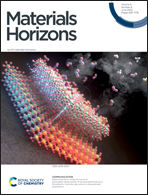Low-molecular-weight supramolecular adhesives based on non-covalent self-assembly of a small molecular gelator†
Abstract
Currently developed adhesives are overwhelmingly polymeric in nature. Herein, we highlight for the first time the potential of supramolecular eutectogels assembled from small molecules as robust low-molecular-weight (LMW) supramolecular adhesives in air, water and organic solvents, and under low temperatures. These supramolecular eutectogels were produced from commercial alkyl trimethyl ammonium bromide (CnTAB) in emerging deep eutectic solvents (DESs), which demonstrated rapid (∼2 min), robust, and tunable adhesion to both hydrophilic and hydrophobic surfaces at room temperature in air. Moreover, high adhesion performance was maintained even in liquid nitrogen (−196 °C), underwater, and in organic solvents. A study of the structure–property relationship of these adhesives and molecular dynamics (MD) simulations further clarified the assembly and adhesion mechanism of the C12TAB molecules in DESs. Compared with traditional polymer adhesives and several existing examples of LMW supramolecular adhesives with solvent-free dry network structures, the spontaneous self-assembly of LMW gelators in versatile DESs provides a new strategy for the facile construction of high-strength supramolecular adhesives with gel network structures for a diverse range of harsh environments.



 Please wait while we load your content...
Please wait while we load your content...